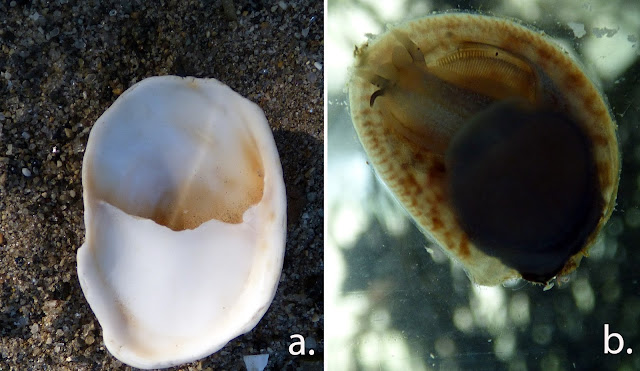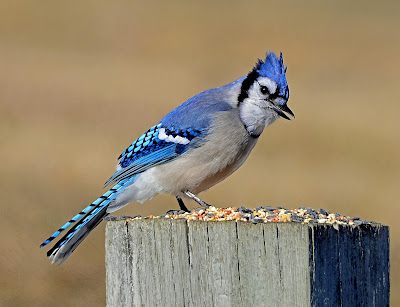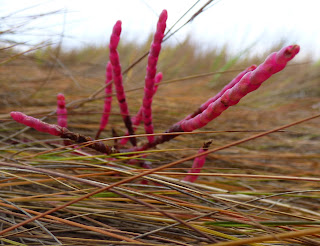NATURE NEWS
Slipper shells are comfortable settling on rocks
Published August 9 2016 in the York Weekly/Portsmouth Herald/Fosters Daily Democrat
We are coming into that perfect window of summer when the greenhead season is over and thoseof us who live near salt marshes can go outside again. The days are warm and breezy, the beach beckons. This time seems all the more wonderful because fall is in the air and we know these days are numbered.
a. Upside-down slipper shell showing the characteristic shelf. b. underside of living slipper shell showing head up towards the left and huge foot. Photos by Sue Pike
While tide-pooling we found limpet-like creatures clinging to the rocks. These were slipper shells, one of my favorite snails, because they look like slippers, have an incredibly interesting life cycle and bear one of the few scientific names that I have managed to remember from my early days in marine biology.
The common slipper shell looks like a flattened snail that has lost its spiraled shell in favor of a smooth cap. Somewhere between 20 and 100 million years ago snails with coiled shells uncoiled their shells and gave rise to slipper shells and limpets. Snails with these uncoiled shells do well in the rocky intertidal where their ability to cling to rocks with their big foot (a bigger foot evolved along with that uncoiled shell) and that smooth low-profile shell that helps waves wash right over them.
Slipper shells are related to limpets but can be recognized by one obvious difference, visible only if you find an empty shell - instead of the empty dome of a limpet’s shell. They have a shelf that covers half of the dome - this is the structure that makes them resemble a slipper (or some say a boat). That shelf helps to support and protect their internal organs and is thought to be a remnant of that spiraled shell.
Unlike limpets, slipper shells are sedentary - once the planktonic larvae settle on a suitable spot in the intertidal the young slipper shell remains there, sculpting its shell to match the surface of the rock so that it can suction cup itself in place (a good reason to not pry these snails off of rocks — they won’t be able to reattach). Because it stays put (the scientific word for this is sessile) slipper shells cannot graze upon algae or hunt for prey like other snails. It is a filter feeder - like a clam or mussel. It pulls water into its mantle cavity (inside the shell) and any plankton in the water stick to the gills and are transferred to its mouth.
Since adult slipper shells cannot move around, they need to live close together in order to mate. When the planktonic larvae settle to the bottom they like to settle on top of other slipper shells and form vertical stacks with the largest and oldest on the bottom. Here’s where their sex life gets interesting - slipper shells are protandrous hermaphrodites, meaning they always start out male, and given the right conditions become female as they mature (they’d be protogynous if they were female first). So, when the planktonic larva settles down on a substrate it is male, and stays male until some signal tells it to become female. If it is the only slipper shell around, it will develop into a female and send out chemical signals to attract other slipper shells to come settle on her, forming a stack of slipper shells with the oldest female on the bottom and younger males on top of it. Think about this, the males are able to directly fertilize the female beneath, even if separated by 4 or 5 other males! When I first learned this, it was in conjunction with the provocative scientific name, Crepidula fornicata.
According to Trevor Norton in “Underwater to Get out of the Rain: A Love Affair with the Sea,” this is how that name arose: “Crepidula fornicata, ‘slipper arch,’ is supposedly because of the shape of the shell reminded the taxonomist of the arches (fornicari) of the aqueducts in ancient Rome beneath which the brothels were situated - hence ‘fornication’.” Did Linneaus (the taxonomist in question) mean fornicate to refer to the arch or to the sexual proclivity of these snails or both - we’ll probably never know, but by bestowing this species name he certainly helped make the name and the life history easy to remember.




Comments
Post a Comment